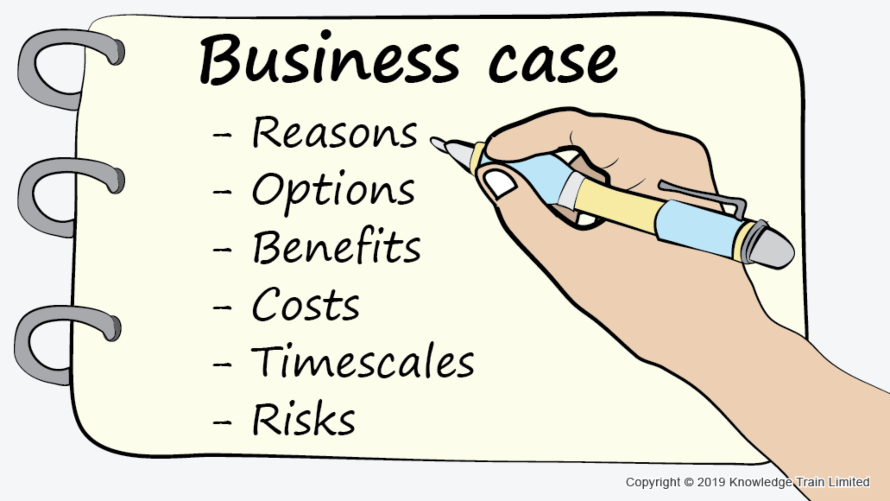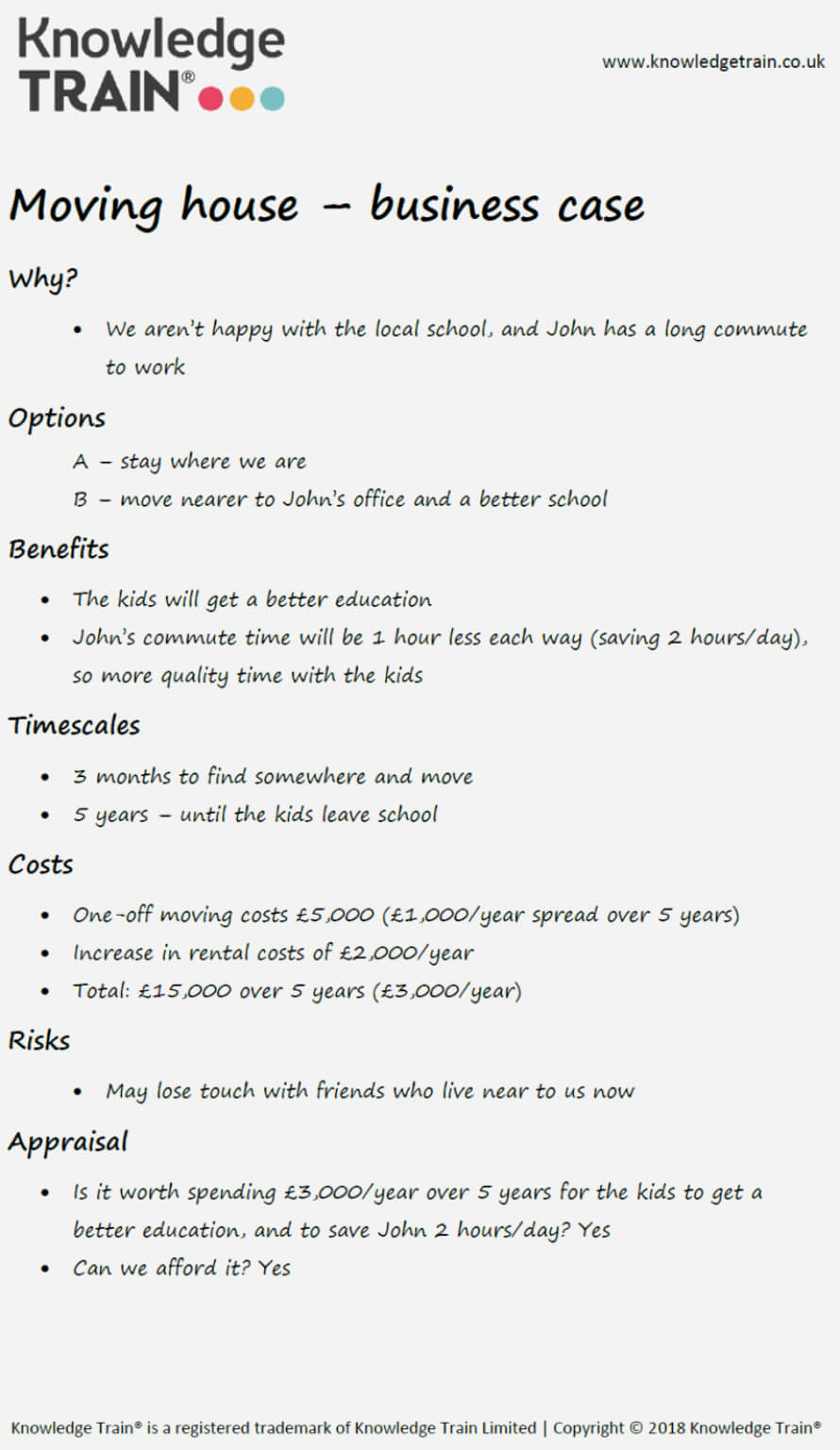
Introduction

This article explains how to write a business case. It includes 2 business case examples and a free business case template for you to download.
You’re probably reading this article because you want to know how to write a business case. Perhaps your organisation is embarking on a major project to develop a new product. Or, perhaps you’re thinking of moving house so your family can enjoy a better life. In either case, you write a business case to ensure the investment is worthwhile.
In this article we’ll give you 2 business case examples, provide you with a simple business case template for you to use, and explain how to write a business case.
What is a business case?
A business case is the justification for some activity (e.g. a project) undertaken by your organisation. It weighs up the timescales, costs and risks of doing the activity against the benefits to be gained. Think of it as weighing up the pros and cons and then taking a sensible decision.
A business case forms an essential component of the curriculum of the best project management courses.
Personal business case
You may also use a business case to justify an investment you make in your personal life. For example, when you’re thinking of moving home to another area. You and your spouse will need to understand the costs of moving, the timescales and risks involved, and weigh these up against the benefits to be gained e.g. saving time traveling to your office, or your children able to go to a better school.
Why have a business case?
Projects should not just start on a whim or because of vanity – although a lot of money has been wasted over the years on such projects.
For business organisations, justification for a project usually takes a commercial form i.e. evaluating how much money could be made from the investment. For example, investing money in developing a new software app to bring first to market, might be deemed to bring certain monetary benefits (in terms of sales) which exceeds the costs of investment.
For government organisations, justification is probably not a commercial one, but could be based upon giving value for money to achieve certain benefits. For example, a public health campaign extolling the benefits of flu-vaccinations for elderly people, might be judged as giving greater value for money than having no campaign, and instead relying on treating patients in hospital once they have contracted the virus.
With so many competing claims being made on scarce funds, organisations need the assurance that the decision they are taking is the right one. After all, there will not be enough funds to pay for all the ideas for projects which are floating around the organisation.
Who uses a business case?
Business cases can be used by many different levels of management within an organisation. Not only are they used to justify the investment in an individual project, but also they are typically used by a portfolio management office to help it decide which projects will contribute to the organisation’s strategic goals. That way, they can filter out the bad ideas for projects, and only fund projects which will contribute to strategic goals.
A business case is also often used by a project sponsor or project executive to help it decide if they should invest in a specific project.
In all cases, the business case must be written and approved prior to any major commitment of resources.
What form does a business case take?
Business cases can take many forms – digital or analogue. The tools you use to create one are also many and varied. Common business tools such as Microsoft Office might be used. Rather than being a document or slide deck however, it could equally be in the form of an email.
Equally, a business case could be written by hand on a whiteboard or flipchart, or on the back of a cigarette packet!
What you should always remember is that a business case does not have to be a huge long document. In fact, it should be as short as possible, and only include the most important information. That way it cuts out the noise and provides decision-makers with just the right information to enable them to take sensible decisions.
For those of you interested in project management, the project management methodology known as PRINCE2 focuses its decision-making on a project on having a viable business case.
Business case examples
We will now give you 2 business case examples. The first example is one which you might find useful for taking decisions in your personal life. The 2nd business case example is more business focused project.
Business case example 1: Moving home
Suppose you and your spouse are considering moving to a new home. You will need to weigh up the pros and cons of moving. This is done using a business case. You might not call it that, but that’s what it is. Let’s look at an example.

Reason
As you can see from the example, the first thing to be clear about in a business case is the reason for doing the project or activity. In this example, the couple has answered the question Why? In fact, there are two problems here – the local school and John’s long commute.
Options considered
A business case should weigh up the competing options which have been considered. After all, there is usually more than one option. Perhaps an alternative option would have been for John to change his job to one nearer their current house. However, this wouldn’t solve the issue with the school.
Benefits
The benefits of a project or activity are the positive things you’re going to get back in return for your investment of time and money. In this case, the kids will get a better education, and John will save time each day.
Timescales
It’s also important to understand how long the investment of resources will take. This is so that the organisation (or family in this case) knows when the resources will be freed up to work on other projects or activities.
There are usually 2 timescales to consider. First, the timescale of the project or activity – in this case 3 months to find a new house and move there. Second, the time over which the benefits shall be realized. In this case it’s 5 years until the kids leave school.
Costs
The costs of doing the project or activity is the next important bit of information. On this project, the costs of moving to a new house will be £5,000. These are the project costs.
However, the couple will spend an additional £2,000/year for every year over which the business case is calculated. For a project in an organisation, this is usually referred to as the operational costs of maintaining and operating the projects outputs e.g. an IT system. At this point, the couple knows the total costs over the timescales when the benefits shall be realized.
Risks
For any activity or project, it’s also important to understand the major risks involved. Risks are the uncertain things which may or may not happen during the period of the investment. There is only one risk identified here, which is the risk that the couple might lose touch with friends who live close to them right now.
Investment appraisal
The next section is where the costs and timescales and risks are weighed up. For this project, it’s a simple decision for the couple to decide if it’s worth spending money over the next 5 years to give their kids better schooling and to save John 2 hours a day commuting.
For an organisation to decide if an investment is worthwhile, however, there are several different ways in which it can decide about the investment.
Often in organisations there are rules defined to help business analysts or project managers write what’s called an investment appraisal. In the next example, we’ll look at one example known as net benefits.
Business case example 2: Handheld device project
Imagine a heating repair services company that uses a paper-based set of forms filled in by an engineer during site visits. The spare parts required to fix the heater are recorded on a form which is given to staff to process back in the office. They then order the parts, and schedule a follow-up visit for the engineer to fix the heater.
Let’s now look at this example business case.

Executive summary
This sample business case contains an executive summary. This section briefly describes the selected option and the key benefits it will bring.
Reasons
The reasons for the project are clearly spelled out when describing the 3 current problems which the company faces.
Options
In this example, there are 2 options (other than do nothing) which have been examined. Each option is summarized and the reason why option 3 is the preferred option has been stated.
Benefits
The expected benefits of reduced overheads are clearly stated. Benefits should be measurable and quantifiable. That means that the benefits can be measured later. But what about the reduced errors, rescheduled appointments and customer contract cancellations? Aren’t they benefits?
Well, these are in fact something else – they’re called outcomes. Outcomes are the results of the changes which come about by using the new handheld devices. The ways you measure the improvements resulting from these outcomes are known as benefits.
Dis-benefits
This example also contains a dis-benefit which is that the back-office staff morale will be lower due to reduced overtime payments. A dis-benefit, if you’re wondering, is a negative consequence of a project. It’s not the same as a risk which implies something uncertain. A dis-benefit is something which you know will happen because of the project and it has negative consequences for the organisation. It’s the opposite of a benefit!
Timescales
Just as we saw in the previous example, the business case contains 2 timescales – the project timescales (i.e. the time it will take to complete the project) and the benefits realization timescales (i.e. the time over which benefits are expected to be realized).
Costs
Again, there are 2 costs – project costs and the ongoing operational costs over the benefits realization timescale. When the decision is taken whether to invest in this project, the total costs (i.e. project costs and ongoing operational costs) are weighed against the expected benefits over the same time period.
Risks
One major risk has been identified in this example, but on your project, there could be many risks.
Investment appraisal
The final section is the investment appraisal. The investment technique used in this example is called net benefits. As you can see from the table, the project and operational costs are recorded for each year of the investment.
The project lasts 1 year which is why the project costs are zero after year 1. Of course, the benefits won’t be realized until the solution is in place and the company starts to use the handheld devices.
The net benefits are simply the total benefits minus the total costs. This shows that the company will start to get a return on its investment sometime towards the end of year 2. This knowledge is vital if the decision-makers are to take a sensible decision about whether to invest in the project.
Business case template
This simple business case template is free to download.
Summary
A business case is the most important document on any project. That’s because it justifies the investment.
It helps an organisation be clear about why a project is needed, and what the results of the investment will be. This is crucial because no organisation has unlimited funds to spend on an unlimited number of projects. Therefore, a business case gives confidence to senior managers when deciding to invest in one project rather than another.
However, as you have seen in this article, a business case is something which you can find useful when taking major decisions in your own personal life. Remember – a business case doesn’t need to be a lengthy document. It could easily be a few notes scribbled on the back of something or even sent in an email.
Whatever form your business case takes, remember one thing – it will help you or your organisation take sensible decisions about committing time and resources to a project or activity.
Remember, if you want to learn more about developing a business case, and learn many of the techniques useful for assessing business problems, consider attending a classroom business analyst course, or business analyst course online
Business case FAQs
Who approves a business case?
Usually on a project, the project sponsor (the person or people who are committing the funds) will approve a business case. Before approving it, they need to have confidence that the problems have been addressed and the right solution has been selected, that the benefits are achievable and realistic, when the investment will pay off, and how big will the return on investment be.
What makes a good business case?
As you have seen in this article, there’s several important bits of information which goes into a business case. Don’t spend unnecessary time though adding information which isn’t required. Your project sponsor will have to read your business case before they approve it, and you don’t want to make their job any harder than it already is!
There are several things you can use to check whether your business case is adequate or not. Here’s a checklist of 13 questions to ask yourself before you submit your business case to your sponsor for approval:
- Are the reasons for the project consistent with the corporate, portfolio or programme management strategies?
- Is the project plan aligned with the business case? (e.g. are the costs and timescales in the project plan correctly reflected in the business case?)
- Are the benefits clearly identified and justified?
- Is it clear how the benefits will be realized?
- Is it clearly defined what will judged a successful outcome?
- Is the preferred business option clearly stated, along with the reasons why?
- If the project requires external procurement, is the preferred sourcing option stated, and why?
- Is it clearly stated how any necessary funding will be obtained?
- Does the business case include non-financial, as well as financial criteria?
- Does the business case include operations and maintenance costs and risks?
- Does the business case include project costs and risks?
- Does the business case conform to organisational accounting standards (e.g. break-even analysis and cash-flow conventions)?
- Are the major risks faced by the project explicitly stated, together with any proposed responses?
How do you write a good business case?
A good business case must contain certain key information including:
- The reasons for doing the project;
- The business options which have been considered, including the base business options of do nothing, so something, or do something else;
- Project and operational costs;
- Project and operational timescales;
- Benefits, expressed in measurable terms;
- Investment appraisal (or cost benefit analysis);
- Major risks and their mitigation plans;
How long is a business case?
A good business should be long enough that it contains all the information needed for the decision-makers to take an informed decision about whether to invest in the project. That means, remove any waffle, and only include information which helps decision-making.
What’s included in a business case?
The following are the most important items to put into a business case:
- Executive summary – summarizes the key points;
- The reasons for the project (answers the question ‘Why are we doing this?’);
- The options considered – e.g. do nothing, do something, or do something else – (answers the question ‘What’s the best option?’);
- The expected benefits – in measurable terms – (answers the question ‘What’s the return?’);
- Costs – both project and operational – (answers the question ‘How much will it cost?’);
- Timescales – for the project and for realizing benefits – (answers the question ‘How long will it take?’);
- Investment appraisal – weigh up costs, times, risks against benefits – (answers the question ‘Is it worth it?’);
- Major risks – (answers the question ‘What if?’).
What is a business case template?
A business case template serves as a starting point when writing a business case. It is reusable and can be used across all your projects. Depending upon its needs, your organisation may have different business case templates, each one used for different scales of projects.
You can download an example business case template here.
What is the purpose of a business case?
The purpose of a business case is simple – it’s used to justify an investment in an activity. Typically, in an organisation this activity is a project. It helps give confidence to management that their investment is worthwhile and will realize benefits for the organisation.
Who owns a business case?
A business case is owned by the person who is funding the project. The name of this role is different across organisations, but commonly this role is known as a project sponsor, or project executive.
By owning the business case, it means this person is accountable for ensuring that any investment decisions which are taken based upon the information within the business case are worthwhile.








